More actions
| (41 intermediate revisions by 5 users not shown) | |||
| Line 1: | Line 1: | ||
{{Info religion | {{Info religion | ||
|image = | |image = Aconismshield.png | ||
|pronunciation = Dra- | |pronunciation = Dra-con-ism. | ||
|origins = | |origins = Start of recorded history | ||
|deities = | |deities = One unified Pantheon with three Factions | ||
|}} | |}} | ||
Draconism as a religion represents an organized faith that worships dragons. Dragons are a specific class of being, somewhere in between an ancient civilization of immortals, and technicians who keep the basic functions of the world running. While many other Religions are about the Gods teaching mortals virtues and sins and guiding them to live a good life in worship and being, Dragons are less sentimental about worship and rather take mortals on a journey with them in the operation of the world and preservation of life against outside foes. | |||
==Origins== | ==Origins== | ||
Draconism | Draconism has invariably existed for all of time, but never quite in the same shape or form. Every cycle of civilization has had some form of Dragon worship, some more popular than others, with different Dragons, and different ideals. The modern version of Draconism first came into being among the early Ailor tribes and the Allorn Empire, which always contained some waning and waxing population of Dragon Cultists. Up until the Cataclysm, Draconism was a deeply disorganized religion with different cults and beliefs held in nearly every country. When the Cataclysm happened, many of the Dragons disappeared, some mysteriously, others with a clear message that the time of Dragons was over. This Long Death as it was later referred to, lasted for 300 years, until the Dragons came back one by one, and proclaimed an end to the Long Death, based on a breakdown of the consensus among them about the intentions of passing the Mantle of Creation to mortals. Since coming back, the Dragons have made efforts to organize Draconism into an actual fully fledged Religion, to acknowledge and reward their followers for their belief, even if unlike other Gods they are not strictly incentivized to seek out worship, and sometimes even seem uncomfortable with the idea. | ||
==Core Beliefs== | |||
===Central Message=== | |||
The central message of the Draconism faith is that there is no true purpose to anything but the continuation and expression of life itself. Draconism acts as a shield against unnatural death, but also as a guarantor of the perpetual cycle of life and death so that reality itself can perpetually experience all the colorful and vibrant expressions of being alive. There are no virtues or vices to be expected of Mortals, with the only real demand that Dragons have, being to obey their rulings towards The Presence, and to preserve life and free will worldwide. Any believer passing into the afterlife has their soul raised up to the cosmos and turned into one of many countless stars from where the living can gaze up at a memory of them. No separate section with information about the Afterlife will be provided because there is nothing else to be said about it. | |||
===Mantle of Creation=== | |||
The Mantle of Creation is a concept held by Dragons that informs a more technical approach to Draconism. Dragons control the various functions of the world of Aloria, from the cycle of birth and death to the patterns of weather, material existence, the passage of time, and so forth. The world functions because they continue to make it function, and in some way, that can cause mortals to hold them as Gods to give thanks and praise for the reality they have created and enabled. To many, the Dragons are distant and mysterious, because they do not always explain their actions or intentions. The Mantle of Creation has a lot of implications, discussed further down in the Expanded Lore section, but for now only a short introduction will suffice. | |||
==Gods and Goddesses== | |||
Draconism has one unified pantheon, but the pantheon is split between two opposing factions, ruled over by a neutral mediating Dragon-King who does not take sides but resolves conflicts when they arise. Their opposition is rooted in how both sides want to deal with Demons from any of the Dimensions. All Draconists should worship all Dragons equally (though can choose a patron Dragon), but should also choose one of the two factions: | |||
* '''The faction of the Great Calm''', including the Dragons Marik, Gaia, Orion, Julianus, Daiana, Felicula and Armina, believes that Demons if they follow the laws of life and agree to be bound by Draconist ritual, should be allowed to exist and thrive in the world of Aloria. | |||
* '''The faction of the Scale Pact''', including the Dragons Triton, Aurora, Nox, Cinerius, Umbra, Severena, and Silas, believe that Demons if they follow the laws of life and agree to be bound by Draconist ritual, owe it to mortals to serve eternally as soldiers in the war against other Demons. | |||
===Regulus, the Dragon-King=== | |||
[[File:Cedragonneww.png|left|frameless|250px]] | |||
Regulus is the Dragon-King of the entire Draconist pantheon and acts like an impartial mediator and problem solder within the pantheon, but also as a leadership and authority dragon for his worshipers. Regulus controls the domains of weather and time on Aloria and is as such often depicted with lightning. His heralds are birds, most commonly his Falcon named Princess. Regulus is prayed to for good weather in travel and fair winds for crops, but also for an understanding of future visions and the threads of time which Draconists are often plagued by. He is a patron of leaders, mentors, guides, and any other who seek to help those in need with guidance and words of wisdom, even if his personal guidance is often capricious. | |||
Regulus has a moderating role in the pantheon, as he was born a mortal in the Regalian Empire, but discovered his Dragonsoul at a later point in life. Having lived a life as a relative nobody in the backdrop of an extensive Imperial family, and now saddled with the immortal duties of Godhood, he strikes a fine balance between duty and understanding the impracticalities of faith on the ground. Regulus has deeply personal ambitions and wants, that constantly clash with his responsibilities and leave him conflicted and difficult to understand for outsiders. There are many still around in Regalia who remember him as a mortal. | |||
===Triton, the War Dragon=== | |||
[[File:Voiddragon.png|left|frameless|250px]] | |||
Triton is both Dragon-God and Demon-God at once, a split personality from when the now-dead Dragon Caius entered the Void during the first Void Invasion and was fractured. While Caius limped back to Aloria, Triton was trapped in the Void and grew in power there. Triton is often held with distrust because of his attachment to Evolism as a God, but also because his existence in Aloria was predicated on the slow agonizing death of Caius. When Caius did eventually die, Triton was able to break into Aloria, and while Caius himself was succeeded by Cinerius in a reincarnation, Triton assumed the role of War Dragon previously held by Caius. He is worshiped for good fortune in war and also for victory in personal battles and duels. | |||
Triton is eternally vague or avoidant whenever challenged about his true loyalties. He states one thing to Draconists, and another to Evolists, leading to many circulating theories. Generally, though, worshipers hold that more than one version of the truth can be valid because Gods always seek to expand their power in Aloria by gaining more followers. While the Dragons are generally more distant and haughty than other Gods in this activity, Triton is prone to the vices of the Void and as such seeks more power and influence. Even if some faithful are repulsed by his Void-based nature, they cannot deny his immense power. | |||
===Marik, the Leytech Dragon=== | |||
[[File:Yayh.png|left|frameless|250px]] | |||
Marik is the lord and master of the Leylines, an intangible network of Dragon power that extends over the world like a vascular system, feeding all of their installations with power and information. Dragons are not omnipotent, and just like other Gods, are bound by the laws of presence and influence around them. Marik's leylines extend the reach of Dragons, allowing them to act globally, for example, allowing Regulus to project weather patterns across the world while never leaving his home in Anglia. Marik also fuels the Leysystem with Soulcores and Unicores, self-operating drones that maintain by now collapsing and decaying infrastructure. Marik is worshiped for good fortune in technological pursuits and for success in professional employment. | |||
Marik was recently reborn, however, sometime before the Dragons returned. Marik instead was reincarnated by the enigmatic Primeval the Everwatcher, the high God of the Unionist faith, and as such, doubles as a Draconist God and a Unionist God. Marik's position is complicated because Draconists believe he is foremost Marik the Dragon, while Unionists claim he is foremost their god Al-Asir. Marik himself dubiously avoids the subject but conspicuously resides among the Skyborn of Ard-al-Nur, while remaining generally absent from Dragon matters, attempting to mend the hostility between Dragonkin and Skyborn. | |||
===Gaia, the Nature Dragon=== | |||
[[File:New_Canvadddsrtetgr.png|left|frameless|250px]] | |||
Gaia is the creator Dragon of all things flora in nature. Gaia designs the trees, the plants, the flowers, and all non-sentient life matter that form the very basic foundations of the food chains all over the world. Gaia is considered a very anti-social Dragon, in the sense that he rarely speaks with mortals, yet is touched to help them by the convictions of his lover. Gaia is worshiped to restore blighted landscapes and environments, but also for protection against the natural dangers of the dense forests, and for plants to clear the way out for anyone lost. It should be noted that not all plants are actually by Gaia's design, as many Gods of other Religions claim the mantle of nature-God, and invariably change plants in their domain to suit them. | |||
Gaia was killed by Teled Elves during the Mage Wars, but his soul was preserved as Dragons never truly die. The current vessel of his Dragonsoul is Iorwerth, once a mortal Aelrrigan Knight from Kintyr who was trapped by the Death Gods to become a servant of the Malefica to save the soul of his lover. Iorwerth acted on behalf of the Malefica for many decades, but was freed by the intervention of mortals in Aloria, and then tasked to carry the Dragonsoul as his burden for serving the Death Gods. He remains scarred by Dark Metal shards embedded in his body, but now enjoys freedom from the control of the Malefica with his lover. | |||
===Silas, the Shaper Dragon=== | |||
[[File:Silasvilkensit.png|left|frameless|250px]] | |||
Silas is the Dragon of shaping, making, and crafting. He inspires the combination and processing of raw materials into objects of beauty and function, and so his worshipers pray to him for excellence in their craft. It is said that Silas was the first to strike a hammer on anvil and teach every kindling civilization how to forge bronze and iron. Draconists believe that the first swords used in the first wars on Aloria, were forged in the likeness of his metallic scales and that the Dragonforges that lie hidden across the world hold ultra-rare ingredients and materials long lost to time by which to craft powerful Artifacts. Indeed, Silas is also the power engine behind all Draconist Artifacts, even if commissioned by other Dragons. | |||
While Aurora is traditionally seen as the Dragon to create all sentient beings of Aloria, this is not actually true in the sense that Silas has created all civilization-faring peoples of Aloria. While Aurora is adept at precisely organizing food-chains of complex animal-life, only Silas knows the Elderlaw principles of higher cognitive ability Creation Particles required to form the people of Aloria, while they are born in Aurora's craters, they are shaped by Silas. Silas's most recent magnum Opus, or so it is believed, is the Urlan, a far cry from his first designed Mud-men. Though, he is far more enigmatic than Aurora and is often forgotten. | |||
===Severena, the Protector Dragon=== | |||
[[File:New_Canvashgfhgnfgg&hhhh.png|left|frameless|250px]] | |||
Severena is the Dragon of protection and guidance, a Dragon that has inspired whole civilizations into the act of world guardianship. She inspires all to shepherd and shield those too weak to defend themselves and empowers her followers to protect them from harm, most chiefly the Demons who have come to bring ruin to Aloria. While Triton is considered the General to issue commands, Severena is the frontline commander who joins the fray with the Archon and Leytech machines. Triton remains in the shadows with his plots, while Severna brandishes her blades and talons to protect not only her charge, but also those who have chosen to sacrifice their life in the line of duty for Dragons. She is prayed to for protection and liberation from oppression. | |||
Severena did not traditionally die or disappear like the other Dragons at the end of their reign around Cataclysm. Rather, she and her clade of Dragons entered an eternal slumber that froze the Jade Seas around the Zhong Kingdoms, the traditional homeland of the Sihai. This event also created the Jade Walls, massive walls of frozen sea waves that protect the Sihai lands from their periodic Demonic attacks, as massive lumbering beasts called Akula attack from the seas. Lately, the Jade Walls have shown signs of cracking and melting, leading many to fear the imminent awakening of the Dragons and the disappearing of their protections. | |||
===Aurora, the Life Dragon=== | |||
[[File:Auroragoddess.png|left|frameless|250px]] | |||
Aurora is the Dragon of Life and Creation, traditionally held as the chief administrator of the Creation Particles, the Elderlaw principles used to create living bodies and design organisms. From the smallest creatures that require microscopes to see, to massive sky whales and dune snakes, Aurora crafts the food chains of the world, carefully balancing predators and prey, scavengers and providers. She designs each creature with the intent to live and continue the cycle of life and death, a dance between herself as the Life Dragon, and Umbra as the Death Dragon. It is her love for Umbra and his for her, that causes them both to appear as halves of each other, elements of white and black in equal balance and never truly meet. She is worshiped for good hunts and healthy children. | |||
Aurora has a personally painful history, from the Cold March during which she led the Dregodar north into Ellador, to her eventual demise at the hands of the Dwarves where she became the Undead Dragon Frisit, or so the Dregodar becoming Isldar had thought. Aurora's body was actually possessed by the Ordial Entity known later as Frisit, an agent of the Death Goddess the Glacial, who was plotting to subject the Isldar to her rule and expand her domain in Aloria through their deadly means. When Aurora was revived, this plot was revealed, immediately plunging the Isldar into Civil War while Aurora retreated to her Craters of Creation to restore damaged ecosystems. | |||
===Nox, the Knowledge Dragon=== | |||
[[File:Dueuaj.png|left|frameless|250px]] | |||
Nox is traditionally held as the Dragon of Knowledge, but his unofficial title is the Dragon of Deceit, Plotting, and Scheming. Nox is the architect of the Codexes, the Draconic sites that hold information of the past 130,000 years recorded in painful detail, something that makes his sites particular targets by nefarious actors. He is however skilled in deploying all this knowledge to hide, obfuscate his intentions, and even plot around fellow Dragons to get his way, most notoriously in the creation of the Slizzar that caused him to be imprisoned for over a hundred thousand years, while he continued to influence the world through them. It is said that Nox used Elderlaw to create mirrors on Aloria, or the concept of reflection, leading his enemies to smash mirrors. | |||
Nox is sometimes held with distrust among the faithful, especially those who harbor resentment towards the Slizzar for having been created in an act of defiance by Nox, but also because Nox while being an upstanding Dragon God, is still entertaining his own plots away from the other Dragons without their knowledge. This has also led some who hold him as patron to consider themselves above the common Draconist faithful and imitate their lord in his game of scheming against their own erstwhile allies. Nobody can deny, however, that Nox is one of the few remaining unbroken consciousnesses that has been alive since the beginning of time, and thus has endless knowledge. | |||
===Orion, the Afterlife Dragon=== | |||
[[File:Orionbsle.png|left|frameless|250px]] | |||
Orion is the steward of the Draconic Afterlife, which makes him a steward of the constellations and stars in equal measure. The Draconists believe that Orion designs the cosmic night sky, the ordained position of all the stars and the celestial bodies, and moves them through the vacuous space beyond the Terrasphere so that sunrises and moon phases occur. Orion is considered a deeply detached Dragon, the only one not present in the Terrasphere (Aloria's atmosphere), roaming instead among the stars and only venturing onto Aloria when summoned by the Dragon Conclave. Many Draconic monks emulate his teachings of earthly detachment and enlightenment, while many priests also consider him a patron due to his relation with death rites. | |||
Orion is one of the few Gods of any Religion that actually cares about atheists and agnostics, always ensuring that they have a place in an afterlife and that their souls do not just explode into nothingness when they die. Orion preserves the souls of the dead without faith among the stars, just like the other Draconists, which some Draconists find difficult to process due to the mental gymnastics one must inherently engage in to be an atheist in a world full of divine providence. They do not believe that atheists should be rewarded with an afterlife when they are so resistant to the common sense of spirituality and the undeniability of divinity. | |||
===Julianus, the Wisdom Dragon=== | |||
[[File:EerkUntitled Artwork.png|left|frameless|250px]] | |||
Julianus is the agent of wisdom and insight, a purely logic and pragmatism-driven Dragon that shows little compassion for the individual but is instead condemned to see the perpetual reality beyond reality. Julianus is the only Dragon that peers into all Dimensions at once, from the Void to the Beyond, and even the realms of the Fae and the Silence. Julianus's utter lack of emotions allows him to drift between existences and observe as a silent witness while remaining unaffected by the natural corruption of these realms due to his apathy. Julianus acts as such like an oracle to the other Dragons, being able to combine Nox's knowledge, and his own sight into other realities, to better predict where Dragon faith should bend and where it should progress. | |||
Julianus is the cause of visions and far-sight that Draconists are sometimes prone to, living dreams and waking realities that bend and show them things they often fail to comprehend. Julianus speaks with such apathy and lack of understanding for mortals, that his god-like perception often becomes a series of incomprehensible images or gibberish speech, which the faithful sometimes spend even years attempting to decipher. Worship of him is often aimed at wishing for an understanding of personal fate, and the insight to avoid calamities, even if the faithful must confess to seek the guidance of other Gods to decipher his messages. | |||
===Daiana, the Ancestor Dragon=== | |||
[[File:Dreamdragon.png|left|frameless|250px]] | |||
Daiana is a bit more complicated to explain than the other Dragons because she does not have a conventional body outside of the projection that she sometimes appears as. Daiana, simply put, is the planet of Aloria itself. Her soul is the core of the world, and her body is the earth mantle that covers her massive inner core that has been described as blinding light in all color spectrums by those who have ventured to certain doors only opened by Artifacts. Her Dreaming manifests whole Religions and even makes changes to reality through Elderlaw, representing ancestry and descendants. When she is worshiped, it is to call upon the Spirits of ancestors to help the living in their struggles, she also fulfills the role of earth-mother and fertility due to the bounty of life on Aloria. | |||
Daiana is the only Dragon that produces Godborn conventionally through her Dreams of Divinity, though all Dragons are actually capable of creating Dragonborn through non-conventional manifestation long after birth. It is believed that Demons who attack Aloria indirectly attack Daiana. She suffers from the corruption that is brought by unregulated Magic and Mages who do not properly vent or dispense with the damage or cost of their Magic to their environment. As such, incorrect usage of Magic, or irresponsible dispensing of Magic, is gravely offensive to Draconists, because it attacks her directly. | |||
===Cinerius, the Passion Dragon=== | |||
[[File:Untitled Artwork-3 3jtds.png|left|frameless|250px]] | |||
Cinerius is the reincarnation of Caius, the previous War Dragon. Caius suffered from the corruption of the Void when he ventured into that realm during the first Void Invasion to understand the enemy. The Corruption slowly ate away at him for 130,000 years, until it finally killed him, and rebirthed him as Cinerius the Dragon of Love and Passion. Caius had always been the Dragon of Love and War, but with his reincarnation, War was inherited by Triton, while Cinerius became an ever-brighter flame of love. It is said that Caius is shrouded in permanent shadow, because to gaze at him would drive mortals insane as they are confronted with every single unspoken desire they have ever had, a realization that some find frightening, wishing not to learn certain things of themselves. | |||
Caius's eventual death and Cinerius's rebirth are somewhat shrouded in mystery, as the faithful and Dragons alike believe Umbra had some hand in the matter with a fair amount of gaslighting. Umbra convinced the whole pantheon for millennia that Caius could only be saved by killing all the Mages and permanently shutting off the Veil. While this theory is technically sound among those who know how the Veil works, there are those who believe this goal was always unattainable, and realistically just distracted the faithful from finding actually actionable solutions to save Caius. In the end however, anyone who asks Cinerius if he would like to go back, will be resolutely rebuked. | |||
===Umbra, the Death Dragon=== | |||
[[File:Newumbraart.png|left|frameless|250px]] | |||
While Nox draws most of the ire from the faithful for potentially having complicated loyalties, Umbra often goes under the Radar due to his silent planning, and his actions that are counted in hundreds of thousands of years. Umbra is the agent of death, the first death in the world was caused by him, and every death continues to be an echo of his eternal demand that life must end, in order for life to begin again. Umbra has designed all diseases, all viruses, and all bacteria that consume. He has caused the Elderlaw of entropy, of decay, and of rot. Together with his great love Aurora, he ensures that there is a perpetual cycle of life and death, among mortals but also crucially among Gods. Even if Gods cannot die traditionally, their metaphoric death gives rise to reborn ideologies. | |||
The faithful often grapple with the eternal necessity of Umbra's design. It is easy to worship Umbra when he sharpens a blade before the kill, or guides an arrow or bullet to its target, but it becomes a lot harder to worship him when the faithful's body is rotting from disease, or ravaged by cancer. Umbra in such a way is worshiped both to help those who inflict death to inflict it fast and painless, but also in a form of fear-worship to pray that his agents of death stay far away and that the individual faithful may have a long and happy life that is not cut short by Umbra's inevitable quota-generated balancing acts. Nobody likes being auto-balanced into the afterlife. | |||
===Felicula, the Arcane Dragon=== | |||
[[File:FeliculaNew Canvasytgfjf.png|left|frameless|250px]] | |||
Felicula is the Dragon of Magic, responsible for upholding much of Elderlaw among the Dragons, but crucially also to allowing Magic to flow into Aloria and to maintain the Veil. Some would claim that her task must thus be to shut down the Veil and prevent Magic from coming through, but her act is more one of balance and conservation, rather than destruction and erasure. Felicula is thought of as the kindest among the Dragons with a great bleeding heart for the fates of the living. It is by her will, that Magic is shaped into something potentially useful. It is by her design, that responsible Magic casting is made possible, because without the order that she creates, Magic is just cancer-inducing rot. She is prayed to for guidance and good fortune in Magic casting, and to be protected from Dark Magic. | |||
It is important to express that extradimensional Magic does not exist because Felicula allows it, but is shaped in a more harmless form because Felicula wishes it for the betterment of mortals both inside and outside the faith. There is truly nothing Felicula could do to prevent Magic from existing in Aloria, so she makes the most of it and generates the Elderlaw principles required for responsible casting and Magic Venting to occur safely. Still, it is believed that it is also by Felicula's design, that those who are Born with Magic have their souls touched by her design and blessed by her goodwill and compassion for others, even if they do not follow in her footsteps. | |||
===Armina, the Community Dragon=== | |||
[[File:Armitlaart.png|left|frameless|250px]] | |||
Armina is the Dragon of Family, kindness, companionship, and community. While Silas designed the first Mud-men, it was Armina who felt they were cold to one another and kissed them with the gift of community and society, thus giving all people on Aloria a longing for companionship and togetherness. Armina embodies the necessity for cooperation and community, she is the agent of loneliness to all those who reject their loved ones and friends, and the warmth between the oldest of acquaintances meeting once more. Armina is the agent of the Soul Rivers, yet another branch of Dragon power that extends over the whole world just like the Leylines, somehow connecting all living souls on Aloria together with the afterlives of other Religions. | |||
Armina remains missing or presumed dead in the modern era, due to her complicated relationship with Avinla among the Suvial Elves. While Avinla was a Goddess of the Estelley Pantheon which at times has posited itself as an enemy of Draconism, Armina and Avinla were two peas in a pod when it came to the Suvial people, and the reasons why their society is split between the two Religions. It is not within the power of individual Gods to suspend the death of millions of people, and as such, it is often speculated that Armina is actually responsible for the undying nature of the Suvial, even if the exact nature of the situation is badly understood due to her absence. | |||
==Priesthood== | |||
Priesthood for Draconism is more complicated than one might assume at first glance from a Religion that was effectively dead for 300-odd years while most Dragons were either in slumber or in a near-death state. At the end of the Immortal War, the Dragons decreed that the Mantle of Creation (the theoretical stewardship over the world's functions) was to pass to mortals and that they too would become mortal (explanation on why they did this is further below). As this occurred around Cataclysm, Draconism as a Religion was effectively dead for 300 years except for among the Sihai where the Dragons could still be visited, or the Isldar who were deceived. Still, when the Dragons returned centuries later, they found that much of the priesthood had survived their absence and that in some places, the faith had even grown. The Religion had always been considered more of a curiosity by the Dragons, who never asked to be worshiped, or set out to have a Religion specifically ordained by them. They fully expected everyone to give up on the Religion when they left, but the fact they had not, caused a change to occur. | |||
The structures that were still very much in place, were the hierarchy set out before the Immortal War that had more or less survived. At the head of all the priesthood were the Matrons (a non-gendered term) that applied to the single most favored of each Dragon God. Each God had their own Matron, a mortal who would have their favor, and know most personally their wishes and ambitions for the world, and could translate them to the other faithful. This position was often elective, but some Matrons passed their lineage from generation to generation, which became especially common after the Denial of Immortality. The only Matron succession that had not survived, was Regulus's Matron, who was eventually chosen from the Isldar to be Gwenyth Zylmoira, leading the faithful into a new era. | |||
Below the Matrons, are the Dragon Priests. Dragon Priests represent the whole religion, but usually specialize in the teachings of a specific Dragon God as their patron, and emphasize their qualities and teachings above the others. Generally speaking though, Dragon Priests should be aware of all other Dragons just as much, and be able to hold their own in theological discussion on the merits and values of the other Dragons too, but also understand the overarching narrative of Draconism as a whole. It is possible to be a Dragon Priest and hold other occupations, as Dragon Priesthood is more of a personal choice than an ordained position. There is no official academy or place of teaching for Priests, the only real requirement is that each self-ordained priest takes a pilgrimage to the Matron of their Patron God, and seeks approval from them. | |||
Below the Dragon Priests are the Dragon Champions. Unlike Dragon Priests, Dragon Champions do not widely act as priests, they are more akin to lay priests but hold an extreme emphasis on specific Dragon Gods. Anyone can be a Dragon Champion, it is in most cases self-declared, but 9 out of 10 Dragon Champions are warriors because they enforce the might and will of their Dragon usually by the sword. This may lead to some comical arrangements, with Felicula Dragon Champions forcing participants to have a party and be happy, with the threat of physical harm if they do not. Dragon Champions can administer religious services, but only specifically to their own patron God, while Dragon Priests can perform more general and widespread religious services. | |||
==Expanded Lore== | |||
The Expanded Lore section contains additional contextual information about the Draconist faith. This section is not necessary to read to get a good understanding of the lore, just the background information. | |||
===Festivals and Worship=== | |||
The [[Draconism Expanded]] Page contains information on Draconism Holy days (one each month), as well as basic rituals performed by Draconism Priests for the faithful. This Page is useful to read for upcoming festivals, but is not necessary to fully explore unless an event is actually upcoming and pinned to the calendar. The bottom of the page contains information relevant to Draconism Priests. | |||
===Relation to Magic=== | |||
Draconism has a historically complicated relationship with Magic that has generally mellowed out over the last few centuries. While originally the Draconist view of Mages and Magic was to utterly burn them out of existence, the reality of the world touched and changed by Magic eventually settled in, and relations to the idea of Magic being in the world normalized. It must always be understood that if the Dragons could have it any other way, they would prefer it if Magic did not exist. After all, Elderlaw, the Magic of Dragons and the fabric of reality, still remains inaccessible to mortals, disabled for their use ever since the first Void Invasion due to the Dragons's mistrust. | |||
Dragon Gods and Goddess do not show any particular favor towards any of the Dimensions, but hold a great disdain for Magic from the Beyond, due to its inherent death-inducing themes and associations. This does not mean that Dragons or Draconists reject anyone with Magic from the Beyond, it just means that the faithful are generally more guarded towards those with indirect connections to the Ordial realm without knowing their exact allegiances or intentions. Draconists in general do not define or color any dimension other than the Beyond with any pre-supposed expectation, and hold all types of Magic and their users responsible for their ultimate conduct, safe Venting, and proper casting procedures. They can however turn hostile against Mages who are careless and corrupt the world, sending Archon after them like holy warriors to rob them of their Magic. | |||
===The Advancement=== | |||
Prior to the Advancement, each Dragon had their own Radical view of how to deal with the Presence, a catch-all term for all things magical in the world, including Demons and Mages and the Afflicted. When Caius died, the Conclave was shaken so profoundly that it re-convened, an event that had only taken place 5 centuries prior to discuss the departure of Dragons from their traditional role as Mantle of Creation. In this Conclave, Regulus abandoned his own Radical, and tried to mediate the Conclave to agree to a common sentiment on the Presence. While agreements were formed fairly quickly on Mages and the Afflicted (namely, that Mages deserved life, and the Afflicted curing or death), no agreement could be made on Demons. | |||
Eventually two camps formed under the nominal leadership of Daiana and Triton, both equally believing fanatically in their views of the Great Calm and the Scale Pact, while the other Dragons each joined these factions. Regulus was the only one who remained impartial, even if the Conclave is in some views seen as a failure on his part to truly unify the Dragons in one ideology. The great benefit it did bring however, was that the Dragons committed to taking their own Religion seriously. While prior, their Religion had been cobbled together beliefs held and proclaimed by mortals, the Dragons committed to decreeing their own beliefs and dogma, so that the faithful could take it directly from them instead of just assuming. | |||
===Old Believers=== | |||
Old Believers of Draconist exist (though it is generally not recommended you play one, due to their hostile relations with both Draconists and non-Draconists). Old Believers of Draconism hold onto the anti-Presence attitude that the Religion once had over 500 years ago, still firmly believing that the Presence (Mages, Afflicted, Demons, etc.) are all alien to the world of Aloria, and must be purged from the world. Most modern Draconists believe that Old Believers are insane blood-thirsty fanatics, but the reality is always a bit more nuanced than claimed. Some have never gotten over the death of Caius and because of their love for that Dragon, continue the burning crusade against the Presence. Others yet, are not comfortable with the radical accepting degree that he Dragons currently show towards Demons. While technically Old Believers generally agree that the Presence should be burnt out of the world, there are degrees of radicalness and pragmatism among them, causing some Old Believers to not outright believe in death for Mages, but just general segregation and population control. | |||
===Dragon Types=== | |||
Dragons are not singular, there exist not just 15 Dragons in the world, but technically hundreds, and even different categories. To make sense of the various categories, this section will explain the differences. | |||
* '''Dragon-Gods''' are the leaders of so-called Clades. Clades are groupings of Dragons that are all of the same type. For example, the Blue Clade belongs to Regulus the Blue Dragon. All of these Blue Dragons control time and rain and storm, but only the Dragon God Regulus is considered a God. The other Clade Dragons are still considered divine, but their power is inherited from the Dragon-God, who holds absolute authority. The other Clade Dragons should be considered like right-hands because Dragons are not omnipotent or omniscient, and can't be everywhere at once. | |||
* '''Clade Dragons''' are the afore-described right-hands of the Dragons. Clade Dragons do not have a consistent number, for example, Regulus has only 6, while Marik has 30 (though many of them remain dead). Clade Dragons appear identical to their Dragon-Gods, but there is no common trend between what certain Dragons look like. The only true commonality is that all true Dragons are massive, sometimes as large as mountains, and thus compare with the Primeval Beings in size. True Dragons can have four legs, only two, six, or none at all. Sometimes they have wings, other times they do not. Sometimes they are long, or stubby, or slither around. | |||
* '''Drakon''' are mortal versions of Dragons that nonetheless live for centuries. It is somewhat unclear if they are directly related to Dragon-Gods or Clade Dragons, or were created to come too close to them in appearance. Drakon always appear like the traditional understanding of a wyvern with two large wings which it can support itself on, two hind legs, a long neck and a long tail. Drakon are large but never quite as massive as true Dragons, being about the size of a Regalia Frigate. Drakon have no inherent Magic, but do have an elemental breath that depends on the Dragon they belong to. For example, Regulus Drakon can breathe lightning, while Cinerius Drakon breathe fire, and Silas Drakon breathe sharp silver shrapnel, and Felicular Drakon breathe ethereal Magic. Drakon are primarily war beasts used by the Dragons to fight Arken and Demons. Only in very rare cases will a Dragon send a Drakon to act as mount for a chosen person for their task. | |||
* '''Drakes''' (often also called Wyverns) are mortal versions of Dragons that live for several centuries but are much smaller than Drakon. Wyvern are just larger than a war-horse, allowing them to comfortable carry multiple persons on their back, but not able to tear down whole buildings like Drakon could. Drakes were created specifically as flying mounts for the Archon and Dragon Champions, and usually bond with mortals as their personal mount. Drakes do not possess any Magic, appear with the same appearance traits as Drakon, and also do not have an elemental breath. | |||
* '''Draconet''' are small mortal versions of Drakes that are no larger than dog-sized. What their exact purpose was is unclear, unlike Drakes and Drakon they have four legs and thus can move around like most mammals, but rarely fly despite being able to do so. Draconets are occasionally kept as pets by worshipers though they are exceedingly rare to find, and usually have to be raised from an egg to acquire the right calm temperament. Draconets were considered a prized possession during the Allorn Empire, but overhunting of their native populations has effectively driven them to extinction in the wild, with only select eggs being held onto for centuries until they hatch for the right person in unclear conditions. | |||
* ''' | |||
* ''' | |||
* ''' | |||
* ''' | |||
=== | ===Dragon or Primeval=== | ||
To cast aside presumptions, Dragons are distinctly not Primeval. While Dragons rarely speak about the pre-Seraph history and existence of the world, they have made clear statements about the idea that when they first awoke, that the Primeval Beings were already there. The only Primeval Beings that the Dragons have ever spoken about, were the Everwatcher, the Blind One, and the Covenant, though for the Covenant she went by a different name and appearance. Dragons believe Primevals to be more powerful than them, and some speculate that in the eternal cycle of creation, that the Primevals actually created Dragons, who in turn created mortals and other Gods, though this is exceedingly hard to prove. There is effectively no communication between the Dragons and the Primeval Beings. The Everwatcher only speaks to the Vessel of Unionism and does so cryptically, the Blind One is in a state of eternal unconscious binding by its followers to prevent it from awakening, while the Covenant seems lost in some higher state of being that makes her interactions with the world seem more instinctual than calculated. The Dragons urge utter caution when attempting to interact or learn more about the Primeval Beings, because what is unknowable to Dragons, will surely spell doom for the mind of mortals. | |||
== | ===God Dreams=== | ||
Dragons create Gods, flat-out. It is necessary to discuss this topic to dissuade furthering logic that because Dragons create Gods, that other Religions are fake and that Dragons should be worshiped instead as the only correct Gods. This is far from the truth, and actively against the intentions of the Dragons even. To first examine how other Gods are made, they are barely tangentially made by Dragons. When enough people on Aloria wish or crave for something, it is often through the optic of divine protection or saving. People generally gravitate in situations of despair and suffering, to wishing for a higher power to wisk them away and protect them, and this naturally becomes a desire for a savior-god. When enough people wish for this, all that emotional energy is felt by the planet itself, which is Daiana. Daiana dreams, but her dreams are never decided upon by herself, they are affected by the emotional energy that permeates the crust from the people living on it. And so, when enough people wish for a God, Daiana dreams of their desire, and Daiana's dreams become manifested reality. Nearly all Gods are thus born from Daiana's dreams by the template and wish provided by the people. There are some corner cases. For example, some Fornoss Gods were Arken who refracted into Godhood, and some Unionist Gods were made Gods directly by the Primeval Being the Everwatcher, but generally speaking, this logic holds true. | |||
It is necessary to express that even though Daiana takes a direct role in the creation of Gods, coupled with the fact that Aurora has indirectly created all species and peoples of Aloria through biological experimentation, that this does not mean anyone owes them their life or obedience or indeed worship. The Dragons primary directive is to create and preserve life, but they take a very apathetic role towards this life after it is created and is able to survive. While the Dragons indirectly aid certain societies by sending Archon or other Dragon forces to fight The Presence, this isn't really to protect specific groups of people, but rather just to counteract The Presence. In many ways, Gods that are dreamed up by Daiana are found family, while Dragons are the actively rejecting family that wants nothing to do with mortals, unless they specifically choose to worship them. Dragons are welcoming to worshipers, but do not demand or expect worship from those who feel stronger kinship with the Gods that were born from their ancestor's wants and needs, and that have always been present to guide them and their ancestors, and will continue to be around for their descendants. This doesn't necessarily stop some Dragon worshipers from acting smug about the technical superiority of Dragons over other Gods, and it is certainly true that some Gods are very weak compared to Dragons and actively hide away from them, but that these persons are never ontologically correct with their attitude. | |||
==Trivia== | ==Trivia== | ||
* Draconism is technically the oldest religion, but due to constant changes in its dogma, it is now actually the youngest Religion, being exactly 1 month old at time of this article writing. | |||
* Sometimes non-named Dragons are very important. It was not by ordaining from Regulus that Dragons returned, but due to the rebellion of Renita, one of his subordinate Dragons. | |||
* Dragons should be considered a form of an advanced civilization that has acquired godhood, but inevitably, there are very limited numbers of them. The Gods just happen to be the leaders of the "Clade". | |||
{{Religion}} | {{Religion}} | ||
{{Accreditation | {{Accreditation | ||
|Artists = | |Artists = | ||
|Writers = MonMarty | |Writers = MonMarty | ||
|Processors = | |Processors = | ||
}} | }} | ||
[[category:Religion]] | [[category:Religion]] | ||
Latest revision as of 08:55, 23 November 2024
| Draconism | |
|---|---|
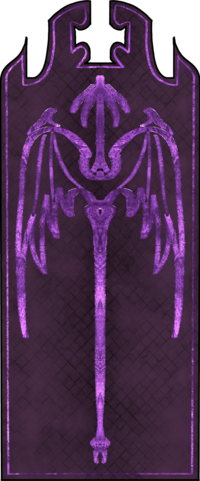 | |
| Religion | |
| Pronunciation | Dra-con-ism. |
| Origins | Start of recorded history |
| Deities | |
| One unified Pantheon with three Factions | |
Draconism as a religion represents an organized faith that worships dragons. Dragons are a specific class of being, somewhere in between an ancient civilization of immortals, and technicians who keep the basic functions of the world running. While many other Religions are about the Gods teaching mortals virtues and sins and guiding them to live a good life in worship and being, Dragons are less sentimental about worship and rather take mortals on a journey with them in the operation of the world and preservation of life against outside foes.
Origins
Draconism has invariably existed for all of time, but never quite in the same shape or form. Every cycle of civilization has had some form of Dragon worship, some more popular than others, with different Dragons, and different ideals. The modern version of Draconism first came into being among the early Ailor tribes and the Allorn Empire, which always contained some waning and waxing population of Dragon Cultists. Up until the Cataclysm, Draconism was a deeply disorganized religion with different cults and beliefs held in nearly every country. When the Cataclysm happened, many of the Dragons disappeared, some mysteriously, others with a clear message that the time of Dragons was over. This Long Death as it was later referred to, lasted for 300 years, until the Dragons came back one by one, and proclaimed an end to the Long Death, based on a breakdown of the consensus among them about the intentions of passing the Mantle of Creation to mortals. Since coming back, the Dragons have made efforts to organize Draconism into an actual fully fledged Religion, to acknowledge and reward their followers for their belief, even if unlike other Gods they are not strictly incentivized to seek out worship, and sometimes even seem uncomfortable with the idea.
Core Beliefs
Central Message
The central message of the Draconism faith is that there is no true purpose to anything but the continuation and expression of life itself. Draconism acts as a shield against unnatural death, but also as a guarantor of the perpetual cycle of life and death so that reality itself can perpetually experience all the colorful and vibrant expressions of being alive. There are no virtues or vices to be expected of Mortals, with the only real demand that Dragons have, being to obey their rulings towards The Presence, and to preserve life and free will worldwide. Any believer passing into the afterlife has their soul raised up to the cosmos and turned into one of many countless stars from where the living can gaze up at a memory of them. No separate section with information about the Afterlife will be provided because there is nothing else to be said about it.
Mantle of Creation
The Mantle of Creation is a concept held by Dragons that informs a more technical approach to Draconism. Dragons control the various functions of the world of Aloria, from the cycle of birth and death to the patterns of weather, material existence, the passage of time, and so forth. The world functions because they continue to make it function, and in some way, that can cause mortals to hold them as Gods to give thanks and praise for the reality they have created and enabled. To many, the Dragons are distant and mysterious, because they do not always explain their actions or intentions. The Mantle of Creation has a lot of implications, discussed further down in the Expanded Lore section, but for now only a short introduction will suffice.
Gods and Goddesses
Draconism has one unified pantheon, but the pantheon is split between two opposing factions, ruled over by a neutral mediating Dragon-King who does not take sides but resolves conflicts when they arise. Their opposition is rooted in how both sides want to deal with Demons from any of the Dimensions. All Draconists should worship all Dragons equally (though can choose a patron Dragon), but should also choose one of the two factions:
- The faction of the Great Calm, including the Dragons Marik, Gaia, Orion, Julianus, Daiana, Felicula and Armina, believes that Demons if they follow the laws of life and agree to be bound by Draconist ritual, should be allowed to exist and thrive in the world of Aloria.
- The faction of the Scale Pact, including the Dragons Triton, Aurora, Nox, Cinerius, Umbra, Severena, and Silas, believe that Demons if they follow the laws of life and agree to be bound by Draconist ritual, owe it to mortals to serve eternally as soldiers in the war against other Demons.
Regulus, the Dragon-King
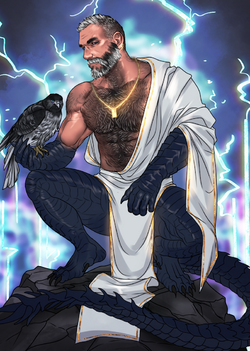
Regulus is the Dragon-King of the entire Draconist pantheon and acts like an impartial mediator and problem solder within the pantheon, but also as a leadership and authority dragon for his worshipers. Regulus controls the domains of weather and time on Aloria and is as such often depicted with lightning. His heralds are birds, most commonly his Falcon named Princess. Regulus is prayed to for good weather in travel and fair winds for crops, but also for an understanding of future visions and the threads of time which Draconists are often plagued by. He is a patron of leaders, mentors, guides, and any other who seek to help those in need with guidance and words of wisdom, even if his personal guidance is often capricious.
Regulus has a moderating role in the pantheon, as he was born a mortal in the Regalian Empire, but discovered his Dragonsoul at a later point in life. Having lived a life as a relative nobody in the backdrop of an extensive Imperial family, and now saddled with the immortal duties of Godhood, he strikes a fine balance between duty and understanding the impracticalities of faith on the ground. Regulus has deeply personal ambitions and wants, that constantly clash with his responsibilities and leave him conflicted and difficult to understand for outsiders. There are many still around in Regalia who remember him as a mortal.
Triton, the War Dragon
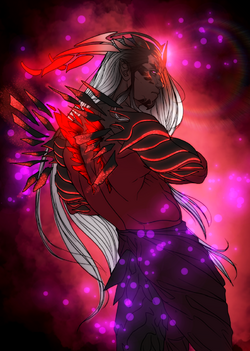
Triton is both Dragon-God and Demon-God at once, a split personality from when the now-dead Dragon Caius entered the Void during the first Void Invasion and was fractured. While Caius limped back to Aloria, Triton was trapped in the Void and grew in power there. Triton is often held with distrust because of his attachment to Evolism as a God, but also because his existence in Aloria was predicated on the slow agonizing death of Caius. When Caius did eventually die, Triton was able to break into Aloria, and while Caius himself was succeeded by Cinerius in a reincarnation, Triton assumed the role of War Dragon previously held by Caius. He is worshiped for good fortune in war and also for victory in personal battles and duels.
Triton is eternally vague or avoidant whenever challenged about his true loyalties. He states one thing to Draconists, and another to Evolists, leading to many circulating theories. Generally, though, worshipers hold that more than one version of the truth can be valid because Gods always seek to expand their power in Aloria by gaining more followers. While the Dragons are generally more distant and haughty than other Gods in this activity, Triton is prone to the vices of the Void and as such seeks more power and influence. Even if some faithful are repulsed by his Void-based nature, they cannot deny his immense power.
Marik, the Leytech Dragon
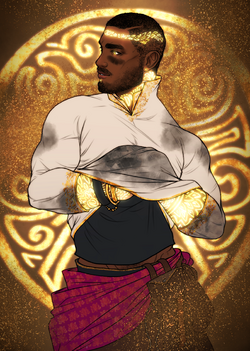
Marik is the lord and master of the Leylines, an intangible network of Dragon power that extends over the world like a vascular system, feeding all of their installations with power and information. Dragons are not omnipotent, and just like other Gods, are bound by the laws of presence and influence around them. Marik's leylines extend the reach of Dragons, allowing them to act globally, for example, allowing Regulus to project weather patterns across the world while never leaving his home in Anglia. Marik also fuels the Leysystem with Soulcores and Unicores, self-operating drones that maintain by now collapsing and decaying infrastructure. Marik is worshiped for good fortune in technological pursuits and for success in professional employment.
Marik was recently reborn, however, sometime before the Dragons returned. Marik instead was reincarnated by the enigmatic Primeval the Everwatcher, the high God of the Unionist faith, and as such, doubles as a Draconist God and a Unionist God. Marik's position is complicated because Draconists believe he is foremost Marik the Dragon, while Unionists claim he is foremost their god Al-Asir. Marik himself dubiously avoids the subject but conspicuously resides among the Skyborn of Ard-al-Nur, while remaining generally absent from Dragon matters, attempting to mend the hostility between Dragonkin and Skyborn.
Gaia, the Nature Dragon
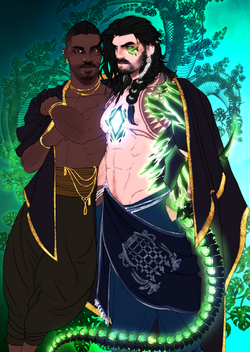
Gaia is the creator Dragon of all things flora in nature. Gaia designs the trees, the plants, the flowers, and all non-sentient life matter that form the very basic foundations of the food chains all over the world. Gaia is considered a very anti-social Dragon, in the sense that he rarely speaks with mortals, yet is touched to help them by the convictions of his lover. Gaia is worshiped to restore blighted landscapes and environments, but also for protection against the natural dangers of the dense forests, and for plants to clear the way out for anyone lost. It should be noted that not all plants are actually by Gaia's design, as many Gods of other Religions claim the mantle of nature-God, and invariably change plants in their domain to suit them.
Gaia was killed by Teled Elves during the Mage Wars, but his soul was preserved as Dragons never truly die. The current vessel of his Dragonsoul is Iorwerth, once a mortal Aelrrigan Knight from Kintyr who was trapped by the Death Gods to become a servant of the Malefica to save the soul of his lover. Iorwerth acted on behalf of the Malefica for many decades, but was freed by the intervention of mortals in Aloria, and then tasked to carry the Dragonsoul as his burden for serving the Death Gods. He remains scarred by Dark Metal shards embedded in his body, but now enjoys freedom from the control of the Malefica with his lover.
Silas, the Shaper Dragon
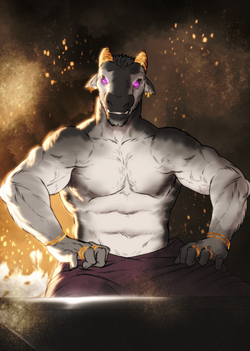
Silas is the Dragon of shaping, making, and crafting. He inspires the combination and processing of raw materials into objects of beauty and function, and so his worshipers pray to him for excellence in their craft. It is said that Silas was the first to strike a hammer on anvil and teach every kindling civilization how to forge bronze and iron. Draconists believe that the first swords used in the first wars on Aloria, were forged in the likeness of his metallic scales and that the Dragonforges that lie hidden across the world hold ultra-rare ingredients and materials long lost to time by which to craft powerful Artifacts. Indeed, Silas is also the power engine behind all Draconist Artifacts, even if commissioned by other Dragons.
While Aurora is traditionally seen as the Dragon to create all sentient beings of Aloria, this is not actually true in the sense that Silas has created all civilization-faring peoples of Aloria. While Aurora is adept at precisely organizing food-chains of complex animal-life, only Silas knows the Elderlaw principles of higher cognitive ability Creation Particles required to form the people of Aloria, while they are born in Aurora's craters, they are shaped by Silas. Silas's most recent magnum Opus, or so it is believed, is the Urlan, a far cry from his first designed Mud-men. Though, he is far more enigmatic than Aurora and is often forgotten.
Severena, the Protector Dragon
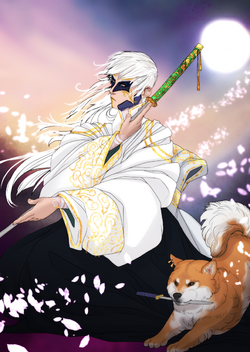
Severena is the Dragon of protection and guidance, a Dragon that has inspired whole civilizations into the act of world guardianship. She inspires all to shepherd and shield those too weak to defend themselves and empowers her followers to protect them from harm, most chiefly the Demons who have come to bring ruin to Aloria. While Triton is considered the General to issue commands, Severena is the frontline commander who joins the fray with the Archon and Leytech machines. Triton remains in the shadows with his plots, while Severna brandishes her blades and talons to protect not only her charge, but also those who have chosen to sacrifice their life in the line of duty for Dragons. She is prayed to for protection and liberation from oppression.
Severena did not traditionally die or disappear like the other Dragons at the end of their reign around Cataclysm. Rather, she and her clade of Dragons entered an eternal slumber that froze the Jade Seas around the Zhong Kingdoms, the traditional homeland of the Sihai. This event also created the Jade Walls, massive walls of frozen sea waves that protect the Sihai lands from their periodic Demonic attacks, as massive lumbering beasts called Akula attack from the seas. Lately, the Jade Walls have shown signs of cracking and melting, leading many to fear the imminent awakening of the Dragons and the disappearing of their protections.
Aurora, the Life Dragon
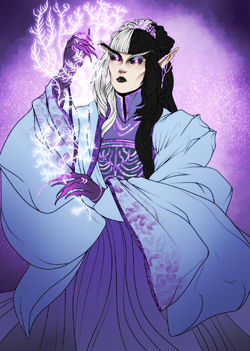
Aurora is the Dragon of Life and Creation, traditionally held as the chief administrator of the Creation Particles, the Elderlaw principles used to create living bodies and design organisms. From the smallest creatures that require microscopes to see, to massive sky whales and dune snakes, Aurora crafts the food chains of the world, carefully balancing predators and prey, scavengers and providers. She designs each creature with the intent to live and continue the cycle of life and death, a dance between herself as the Life Dragon, and Umbra as the Death Dragon. It is her love for Umbra and his for her, that causes them both to appear as halves of each other, elements of white and black in equal balance and never truly meet. She is worshiped for good hunts and healthy children.
Aurora has a personally painful history, from the Cold March during which she led the Dregodar north into Ellador, to her eventual demise at the hands of the Dwarves where she became the Undead Dragon Frisit, or so the Dregodar becoming Isldar had thought. Aurora's body was actually possessed by the Ordial Entity known later as Frisit, an agent of the Death Goddess the Glacial, who was plotting to subject the Isldar to her rule and expand her domain in Aloria through their deadly means. When Aurora was revived, this plot was revealed, immediately plunging the Isldar into Civil War while Aurora retreated to her Craters of Creation to restore damaged ecosystems.
Nox, the Knowledge Dragon
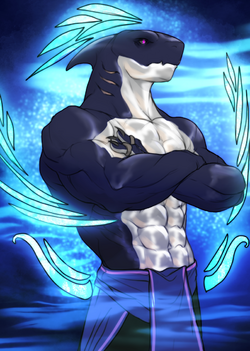
Nox is traditionally held as the Dragon of Knowledge, but his unofficial title is the Dragon of Deceit, Plotting, and Scheming. Nox is the architect of the Codexes, the Draconic sites that hold information of the past 130,000 years recorded in painful detail, something that makes his sites particular targets by nefarious actors. He is however skilled in deploying all this knowledge to hide, obfuscate his intentions, and even plot around fellow Dragons to get his way, most notoriously in the creation of the Slizzar that caused him to be imprisoned for over a hundred thousand years, while he continued to influence the world through them. It is said that Nox used Elderlaw to create mirrors on Aloria, or the concept of reflection, leading his enemies to smash mirrors.
Nox is sometimes held with distrust among the faithful, especially those who harbor resentment towards the Slizzar for having been created in an act of defiance by Nox, but also because Nox while being an upstanding Dragon God, is still entertaining his own plots away from the other Dragons without their knowledge. This has also led some who hold him as patron to consider themselves above the common Draconist faithful and imitate their lord in his game of scheming against their own erstwhile allies. Nobody can deny, however, that Nox is one of the few remaining unbroken consciousnesses that has been alive since the beginning of time, and thus has endless knowledge.
Orion, the Afterlife Dragon
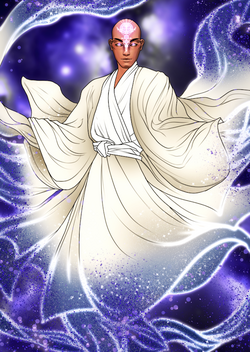
Orion is the steward of the Draconic Afterlife, which makes him a steward of the constellations and stars in equal measure. The Draconists believe that Orion designs the cosmic night sky, the ordained position of all the stars and the celestial bodies, and moves them through the vacuous space beyond the Terrasphere so that sunrises and moon phases occur. Orion is considered a deeply detached Dragon, the only one not present in the Terrasphere (Aloria's atmosphere), roaming instead among the stars and only venturing onto Aloria when summoned by the Dragon Conclave. Many Draconic monks emulate his teachings of earthly detachment and enlightenment, while many priests also consider him a patron due to his relation with death rites.
Orion is one of the few Gods of any Religion that actually cares about atheists and agnostics, always ensuring that they have a place in an afterlife and that their souls do not just explode into nothingness when they die. Orion preserves the souls of the dead without faith among the stars, just like the other Draconists, which some Draconists find difficult to process due to the mental gymnastics one must inherently engage in to be an atheist in a world full of divine providence. They do not believe that atheists should be rewarded with an afterlife when they are so resistant to the common sense of spirituality and the undeniability of divinity.
Julianus, the Wisdom Dragon
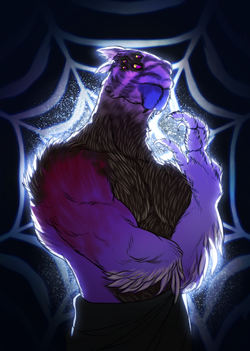
Julianus is the agent of wisdom and insight, a purely logic and pragmatism-driven Dragon that shows little compassion for the individual but is instead condemned to see the perpetual reality beyond reality. Julianus is the only Dragon that peers into all Dimensions at once, from the Void to the Beyond, and even the realms of the Fae and the Silence. Julianus's utter lack of emotions allows him to drift between existences and observe as a silent witness while remaining unaffected by the natural corruption of these realms due to his apathy. Julianus acts as such like an oracle to the other Dragons, being able to combine Nox's knowledge, and his own sight into other realities, to better predict where Dragon faith should bend and where it should progress.
Julianus is the cause of visions and far-sight that Draconists are sometimes prone to, living dreams and waking realities that bend and show them things they often fail to comprehend. Julianus speaks with such apathy and lack of understanding for mortals, that his god-like perception often becomes a series of incomprehensible images or gibberish speech, which the faithful sometimes spend even years attempting to decipher. Worship of him is often aimed at wishing for an understanding of personal fate, and the insight to avoid calamities, even if the faithful must confess to seek the guidance of other Gods to decipher his messages.
Daiana, the Ancestor Dragon
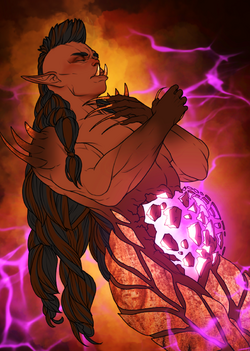
Daiana is a bit more complicated to explain than the other Dragons because she does not have a conventional body outside of the projection that she sometimes appears as. Daiana, simply put, is the planet of Aloria itself. Her soul is the core of the world, and her body is the earth mantle that covers her massive inner core that has been described as blinding light in all color spectrums by those who have ventured to certain doors only opened by Artifacts. Her Dreaming manifests whole Religions and even makes changes to reality through Elderlaw, representing ancestry and descendants. When she is worshiped, it is to call upon the Spirits of ancestors to help the living in their struggles, she also fulfills the role of earth-mother and fertility due to the bounty of life on Aloria.
Daiana is the only Dragon that produces Godborn conventionally through her Dreams of Divinity, though all Dragons are actually capable of creating Dragonborn through non-conventional manifestation long after birth. It is believed that Demons who attack Aloria indirectly attack Daiana. She suffers from the corruption that is brought by unregulated Magic and Mages who do not properly vent or dispense with the damage or cost of their Magic to their environment. As such, incorrect usage of Magic, or irresponsible dispensing of Magic, is gravely offensive to Draconists, because it attacks her directly.
Cinerius, the Passion Dragon
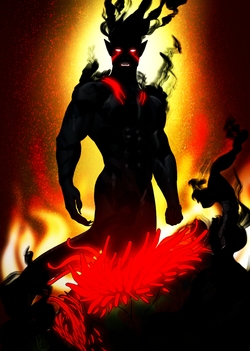
Cinerius is the reincarnation of Caius, the previous War Dragon. Caius suffered from the corruption of the Void when he ventured into that realm during the first Void Invasion to understand the enemy. The Corruption slowly ate away at him for 130,000 years, until it finally killed him, and rebirthed him as Cinerius the Dragon of Love and Passion. Caius had always been the Dragon of Love and War, but with his reincarnation, War was inherited by Triton, while Cinerius became an ever-brighter flame of love. It is said that Caius is shrouded in permanent shadow, because to gaze at him would drive mortals insane as they are confronted with every single unspoken desire they have ever had, a realization that some find frightening, wishing not to learn certain things of themselves.
Caius's eventual death and Cinerius's rebirth are somewhat shrouded in mystery, as the faithful and Dragons alike believe Umbra had some hand in the matter with a fair amount of gaslighting. Umbra convinced the whole pantheon for millennia that Caius could only be saved by killing all the Mages and permanently shutting off the Veil. While this theory is technically sound among those who know how the Veil works, there are those who believe this goal was always unattainable, and realistically just distracted the faithful from finding actually actionable solutions to save Caius. In the end however, anyone who asks Cinerius if he would like to go back, will be resolutely rebuked.
Umbra, the Death Dragon
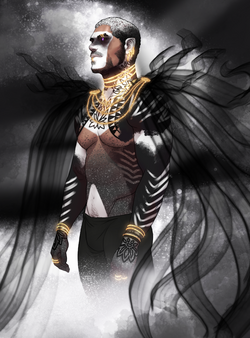
While Nox draws most of the ire from the faithful for potentially having complicated loyalties, Umbra often goes under the Radar due to his silent planning, and his actions that are counted in hundreds of thousands of years. Umbra is the agent of death, the first death in the world was caused by him, and every death continues to be an echo of his eternal demand that life must end, in order for life to begin again. Umbra has designed all diseases, all viruses, and all bacteria that consume. He has caused the Elderlaw of entropy, of decay, and of rot. Together with his great love Aurora, he ensures that there is a perpetual cycle of life and death, among mortals but also crucially among Gods. Even if Gods cannot die traditionally, their metaphoric death gives rise to reborn ideologies.
The faithful often grapple with the eternal necessity of Umbra's design. It is easy to worship Umbra when he sharpens a blade before the kill, or guides an arrow or bullet to its target, but it becomes a lot harder to worship him when the faithful's body is rotting from disease, or ravaged by cancer. Umbra in such a way is worshiped both to help those who inflict death to inflict it fast and painless, but also in a form of fear-worship to pray that his agents of death stay far away and that the individual faithful may have a long and happy life that is not cut short by Umbra's inevitable quota-generated balancing acts. Nobody likes being auto-balanced into the afterlife.
Felicula, the Arcane Dragon
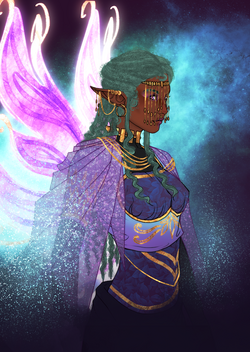
Felicula is the Dragon of Magic, responsible for upholding much of Elderlaw among the Dragons, but crucially also to allowing Magic to flow into Aloria and to maintain the Veil. Some would claim that her task must thus be to shut down the Veil and prevent Magic from coming through, but her act is more one of balance and conservation, rather than destruction and erasure. Felicula is thought of as the kindest among the Dragons with a great bleeding heart for the fates of the living. It is by her will, that Magic is shaped into something potentially useful. It is by her design, that responsible Magic casting is made possible, because without the order that she creates, Magic is just cancer-inducing rot. She is prayed to for guidance and good fortune in Magic casting, and to be protected from Dark Magic.
It is important to express that extradimensional Magic does not exist because Felicula allows it, but is shaped in a more harmless form because Felicula wishes it for the betterment of mortals both inside and outside the faith. There is truly nothing Felicula could do to prevent Magic from existing in Aloria, so she makes the most of it and generates the Elderlaw principles required for responsible casting and Magic Venting to occur safely. Still, it is believed that it is also by Felicula's design, that those who are Born with Magic have their souls touched by her design and blessed by her goodwill and compassion for others, even if they do not follow in her footsteps.
Armina, the Community Dragon
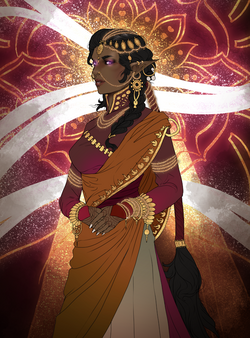
Armina is the Dragon of Family, kindness, companionship, and community. While Silas designed the first Mud-men, it was Armina who felt they were cold to one another and kissed them with the gift of community and society, thus giving all people on Aloria a longing for companionship and togetherness. Armina embodies the necessity for cooperation and community, she is the agent of loneliness to all those who reject their loved ones and friends, and the warmth between the oldest of acquaintances meeting once more. Armina is the agent of the Soul Rivers, yet another branch of Dragon power that extends over the whole world just like the Leylines, somehow connecting all living souls on Aloria together with the afterlives of other Religions.
Armina remains missing or presumed dead in the modern era, due to her complicated relationship with Avinla among the Suvial Elves. While Avinla was a Goddess of the Estelley Pantheon which at times has posited itself as an enemy of Draconism, Armina and Avinla were two peas in a pod when it came to the Suvial people, and the reasons why their society is split between the two Religions. It is not within the power of individual Gods to suspend the death of millions of people, and as such, it is often speculated that Armina is actually responsible for the undying nature of the Suvial, even if the exact nature of the situation is badly understood due to her absence.
Priesthood
Priesthood for Draconism is more complicated than one might assume at first glance from a Religion that was effectively dead for 300-odd years while most Dragons were either in slumber or in a near-death state. At the end of the Immortal War, the Dragons decreed that the Mantle of Creation (the theoretical stewardship over the world's functions) was to pass to mortals and that they too would become mortal (explanation on why they did this is further below). As this occurred around Cataclysm, Draconism as a Religion was effectively dead for 300 years except for among the Sihai where the Dragons could still be visited, or the Isldar who were deceived. Still, when the Dragons returned centuries later, they found that much of the priesthood had survived their absence and that in some places, the faith had even grown. The Religion had always been considered more of a curiosity by the Dragons, who never asked to be worshiped, or set out to have a Religion specifically ordained by them. They fully expected everyone to give up on the Religion when they left, but the fact they had not, caused a change to occur.
The structures that were still very much in place, were the hierarchy set out before the Immortal War that had more or less survived. At the head of all the priesthood were the Matrons (a non-gendered term) that applied to the single most favored of each Dragon God. Each God had their own Matron, a mortal who would have their favor, and know most personally their wishes and ambitions for the world, and could translate them to the other faithful. This position was often elective, but some Matrons passed their lineage from generation to generation, which became especially common after the Denial of Immortality. The only Matron succession that had not survived, was Regulus's Matron, who was eventually chosen from the Isldar to be Gwenyth Zylmoira, leading the faithful into a new era.
Below the Matrons, are the Dragon Priests. Dragon Priests represent the whole religion, but usually specialize in the teachings of a specific Dragon God as their patron, and emphasize their qualities and teachings above the others. Generally speaking though, Dragon Priests should be aware of all other Dragons just as much, and be able to hold their own in theological discussion on the merits and values of the other Dragons too, but also understand the overarching narrative of Draconism as a whole. It is possible to be a Dragon Priest and hold other occupations, as Dragon Priesthood is more of a personal choice than an ordained position. There is no official academy or place of teaching for Priests, the only real requirement is that each self-ordained priest takes a pilgrimage to the Matron of their Patron God, and seeks approval from them.
Below the Dragon Priests are the Dragon Champions. Unlike Dragon Priests, Dragon Champions do not widely act as priests, they are more akin to lay priests but hold an extreme emphasis on specific Dragon Gods. Anyone can be a Dragon Champion, it is in most cases self-declared, but 9 out of 10 Dragon Champions are warriors because they enforce the might and will of their Dragon usually by the sword. This may lead to some comical arrangements, with Felicula Dragon Champions forcing participants to have a party and be happy, with the threat of physical harm if they do not. Dragon Champions can administer religious services, but only specifically to their own patron God, while Dragon Priests can perform more general and widespread religious services.
Expanded Lore
The Expanded Lore section contains additional contextual information about the Draconist faith. This section is not necessary to read to get a good understanding of the lore, just the background information.
Festivals and Worship
The Draconism Expanded Page contains information on Draconism Holy days (one each month), as well as basic rituals performed by Draconism Priests for the faithful. This Page is useful to read for upcoming festivals, but is not necessary to fully explore unless an event is actually upcoming and pinned to the calendar. The bottom of the page contains information relevant to Draconism Priests.
Relation to Magic
Draconism has a historically complicated relationship with Magic that has generally mellowed out over the last few centuries. While originally the Draconist view of Mages and Magic was to utterly burn them out of existence, the reality of the world touched and changed by Magic eventually settled in, and relations to the idea of Magic being in the world normalized. It must always be understood that if the Dragons could have it any other way, they would prefer it if Magic did not exist. After all, Elderlaw, the Magic of Dragons and the fabric of reality, still remains inaccessible to mortals, disabled for their use ever since the first Void Invasion due to the Dragons's mistrust.
Dragon Gods and Goddess do not show any particular favor towards any of the Dimensions, but hold a great disdain for Magic from the Beyond, due to its inherent death-inducing themes and associations. This does not mean that Dragons or Draconists reject anyone with Magic from the Beyond, it just means that the faithful are generally more guarded towards those with indirect connections to the Ordial realm without knowing their exact allegiances or intentions. Draconists in general do not define or color any dimension other than the Beyond with any pre-supposed expectation, and hold all types of Magic and their users responsible for their ultimate conduct, safe Venting, and proper casting procedures. They can however turn hostile against Mages who are careless and corrupt the world, sending Archon after them like holy warriors to rob them of their Magic.
The Advancement
Prior to the Advancement, each Dragon had their own Radical view of how to deal with the Presence, a catch-all term for all things magical in the world, including Demons and Mages and the Afflicted. When Caius died, the Conclave was shaken so profoundly that it re-convened, an event that had only taken place 5 centuries prior to discuss the departure of Dragons from their traditional role as Mantle of Creation. In this Conclave, Regulus abandoned his own Radical, and tried to mediate the Conclave to agree to a common sentiment on the Presence. While agreements were formed fairly quickly on Mages and the Afflicted (namely, that Mages deserved life, and the Afflicted curing or death), no agreement could be made on Demons.
Eventually two camps formed under the nominal leadership of Daiana and Triton, both equally believing fanatically in their views of the Great Calm and the Scale Pact, while the other Dragons each joined these factions. Regulus was the only one who remained impartial, even if the Conclave is in some views seen as a failure on his part to truly unify the Dragons in one ideology. The great benefit it did bring however, was that the Dragons committed to taking their own Religion seriously. While prior, their Religion had been cobbled together beliefs held and proclaimed by mortals, the Dragons committed to decreeing their own beliefs and dogma, so that the faithful could take it directly from them instead of just assuming.
Old Believers
Old Believers of Draconist exist (though it is generally not recommended you play one, due to their hostile relations with both Draconists and non-Draconists). Old Believers of Draconism hold onto the anti-Presence attitude that the Religion once had over 500 years ago, still firmly believing that the Presence (Mages, Afflicted, Demons, etc.) are all alien to the world of Aloria, and must be purged from the world. Most modern Draconists believe that Old Believers are insane blood-thirsty fanatics, but the reality is always a bit more nuanced than claimed. Some have never gotten over the death of Caius and because of their love for that Dragon, continue the burning crusade against the Presence. Others yet, are not comfortable with the radical accepting degree that he Dragons currently show towards Demons. While technically Old Believers generally agree that the Presence should be burnt out of the world, there are degrees of radicalness and pragmatism among them, causing some Old Believers to not outright believe in death for Mages, but just general segregation and population control.
Dragon Types
Dragons are not singular, there exist not just 15 Dragons in the world, but technically hundreds, and even different categories. To make sense of the various categories, this section will explain the differences.
- Dragon-Gods are the leaders of so-called Clades. Clades are groupings of Dragons that are all of the same type. For example, the Blue Clade belongs to Regulus the Blue Dragon. All of these Blue Dragons control time and rain and storm, but only the Dragon God Regulus is considered a God. The other Clade Dragons are still considered divine, but their power is inherited from the Dragon-God, who holds absolute authority. The other Clade Dragons should be considered like right-hands because Dragons are not omnipotent or omniscient, and can't be everywhere at once.
- Clade Dragons are the afore-described right-hands of the Dragons. Clade Dragons do not have a consistent number, for example, Regulus has only 6, while Marik has 30 (though many of them remain dead). Clade Dragons appear identical to their Dragon-Gods, but there is no common trend between what certain Dragons look like. The only true commonality is that all true Dragons are massive, sometimes as large as mountains, and thus compare with the Primeval Beings in size. True Dragons can have four legs, only two, six, or none at all. Sometimes they have wings, other times they do not. Sometimes they are long, or stubby, or slither around.
- Drakon are mortal versions of Dragons that nonetheless live for centuries. It is somewhat unclear if they are directly related to Dragon-Gods or Clade Dragons, or were created to come too close to them in appearance. Drakon always appear like the traditional understanding of a wyvern with two large wings which it can support itself on, two hind legs, a long neck and a long tail. Drakon are large but never quite as massive as true Dragons, being about the size of a Regalia Frigate. Drakon have no inherent Magic, but do have an elemental breath that depends on the Dragon they belong to. For example, Regulus Drakon can breathe lightning, while Cinerius Drakon breathe fire, and Silas Drakon breathe sharp silver shrapnel, and Felicular Drakon breathe ethereal Magic. Drakon are primarily war beasts used by the Dragons to fight Arken and Demons. Only in very rare cases will a Dragon send a Drakon to act as mount for a chosen person for their task.
- Drakes (often also called Wyverns) are mortal versions of Dragons that live for several centuries but are much smaller than Drakon. Wyvern are just larger than a war-horse, allowing them to comfortable carry multiple persons on their back, but not able to tear down whole buildings like Drakon could. Drakes were created specifically as flying mounts for the Archon and Dragon Champions, and usually bond with mortals as their personal mount. Drakes do not possess any Magic, appear with the same appearance traits as Drakon, and also do not have an elemental breath.
- Draconet are small mortal versions of Drakes that are no larger than dog-sized. What their exact purpose was is unclear, unlike Drakes and Drakon they have four legs and thus can move around like most mammals, but rarely fly despite being able to do so. Draconets are occasionally kept as pets by worshipers though they are exceedingly rare to find, and usually have to be raised from an egg to acquire the right calm temperament. Draconets were considered a prized possession during the Allorn Empire, but overhunting of their native populations has effectively driven them to extinction in the wild, with only select eggs being held onto for centuries until they hatch for the right person in unclear conditions.
Dragon or Primeval
To cast aside presumptions, Dragons are distinctly not Primeval. While Dragons rarely speak about the pre-Seraph history and existence of the world, they have made clear statements about the idea that when they first awoke, that the Primeval Beings were already there. The only Primeval Beings that the Dragons have ever spoken about, were the Everwatcher, the Blind One, and the Covenant, though for the Covenant she went by a different name and appearance. Dragons believe Primevals to be more powerful than them, and some speculate that in the eternal cycle of creation, that the Primevals actually created Dragons, who in turn created mortals and other Gods, though this is exceedingly hard to prove. There is effectively no communication between the Dragons and the Primeval Beings. The Everwatcher only speaks to the Vessel of Unionism and does so cryptically, the Blind One is in a state of eternal unconscious binding by its followers to prevent it from awakening, while the Covenant seems lost in some higher state of being that makes her interactions with the world seem more instinctual than calculated. The Dragons urge utter caution when attempting to interact or learn more about the Primeval Beings, because what is unknowable to Dragons, will surely spell doom for the mind of mortals.
God Dreams
Dragons create Gods, flat-out. It is necessary to discuss this topic to dissuade furthering logic that because Dragons create Gods, that other Religions are fake and that Dragons should be worshiped instead as the only correct Gods. This is far from the truth, and actively against the intentions of the Dragons even. To first examine how other Gods are made, they are barely tangentially made by Dragons. When enough people on Aloria wish or crave for something, it is often through the optic of divine protection or saving. People generally gravitate in situations of despair and suffering, to wishing for a higher power to wisk them away and protect them, and this naturally becomes a desire for a savior-god. When enough people wish for this, all that emotional energy is felt by the planet itself, which is Daiana. Daiana dreams, but her dreams are never decided upon by herself, they are affected by the emotional energy that permeates the crust from the people living on it. And so, when enough people wish for a God, Daiana dreams of their desire, and Daiana's dreams become manifested reality. Nearly all Gods are thus born from Daiana's dreams by the template and wish provided by the people. There are some corner cases. For example, some Fornoss Gods were Arken who refracted into Godhood, and some Unionist Gods were made Gods directly by the Primeval Being the Everwatcher, but generally speaking, this logic holds true.
It is necessary to express that even though Daiana takes a direct role in the creation of Gods, coupled with the fact that Aurora has indirectly created all species and peoples of Aloria through biological experimentation, that this does not mean anyone owes them their life or obedience or indeed worship. The Dragons primary directive is to create and preserve life, but they take a very apathetic role towards this life after it is created and is able to survive. While the Dragons indirectly aid certain societies by sending Archon or other Dragon forces to fight The Presence, this isn't really to protect specific groups of people, but rather just to counteract The Presence. In many ways, Gods that are dreamed up by Daiana are found family, while Dragons are the actively rejecting family that wants nothing to do with mortals, unless they specifically choose to worship them. Dragons are welcoming to worshipers, but do not demand or expect worship from those who feel stronger kinship with the Gods that were born from their ancestor's wants and needs, and that have always been present to guide them and their ancestors, and will continue to be around for their descendants. This doesn't necessarily stop some Dragon worshipers from acting smug about the technical superiority of Dragons over other Gods, and it is certainly true that some Gods are very weak compared to Dragons and actively hide away from them, but that these persons are never ontologically correct with their attitude.
Trivia
- Draconism is technically the oldest religion, but due to constant changes in its dogma, it is now actually the youngest Religion, being exactly 1 month old at time of this article writing.
- Sometimes non-named Dragons are very important. It was not by ordaining from Regulus that Dragons returned, but due to the rebellion of Renita, one of his subordinate Dragons.
- Dragons should be considered a form of an advanced civilization that has acquired godhood, but inevitably, there are very limited numbers of them. The Gods just happen to be the leaders of the "Clade".
| ||||||||||
| Accreditation | |||||
|---|---|---|---|---|---|
|
| ||||